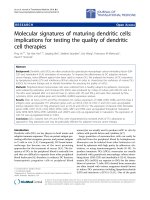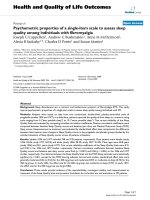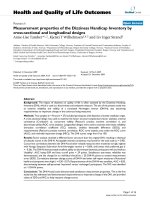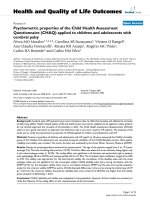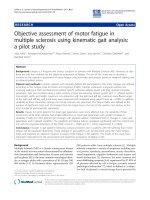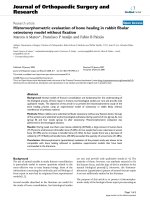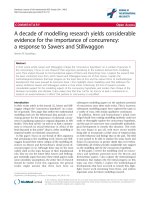Báo cáo hóa học: " Ferroelectric properties of PZT/BFO multilayer thin films prepared using the sol-gel method" ppt
Bạn đang xem bản rút gọn của tài liệu. Xem và tải ngay bản đầy đủ của tài liệu tại đây (1.29 MB, 11 trang )
This Provisional PDF corresponds to the article as it appeared upon acceptance. Fully formatted
PDF and full text (HTML) versions will be made available soon.
Ferroelectric properties of PZT/BFO multilayer thin films prepared using the
sol-gel method
Nanoscale Research Letters 2012, 7:54 doi:10.1186/1556-276X-7-54
Seo-Hyeon Jo ()
Sung-Gap Lee ()
Young-Hie Lee ()
ISSN 1556-276X
Article type Nano Express
Submission date 8 September 2011
Acceptance date 5 January 2012
Publication date 5 January 2012
Article URL />This peer-reviewed article was published immediately upon acceptance. It can be downloaded,
printed and distributed freely for any purposes (see copyright notice below).
Articles in Nanoscale Research Letters are listed in PubMed and archived at PubMed Central.
For information about publishing your research in Nanoscale Research Letters go to
/>For information about other SpringerOpen publications go to
Nanoscale Research Letters
© 2012 Jo et al. ; licensee Springer.
This is an open access article distributed under the terms of the Creative Commons Attribution License ( />which permits unrestricted use, distribution, and reproduction in any medium, provided the original work is properly cited.
Ferroelectric properties of PZT/BFO multilayer thin films prepared using the
sol-gel method
Seo-Hyeon Jo
1
, Sung-Gap Lee*
1
, and Young-Hie Lee
2
1
Department of Ceramic Engineering, Engineering Research Institute, Gyeongsang National
University, Jinju-Si, 660-701, South Korea
2
Department of Electronic Materials Engineering, Kwangwoon University, Seoul, 139-701, South
Korea
*Corresponding author:
Email addresses:
S-HJ:
S-GL:
Y-HL:
Abstract
In this study, Pb(Zr
0.52
Ti
0.48
)O
3
/BiFeO
3
[PZT/BFO] multilayer thin films were fabricated using the
spin-coating method on a Pt(200 nm)/Ti(10 nm)/SiO
2
(100 nm)/p-Si(100) substrate alternately using
BFO and PZT metal alkoxide solutions. The coating-and-heating procedure was repeated several
times to form the multilayer thin films. All PZT/BFO multilayer thin films show a void-free, uniform
grain structure without the presence of rosette structures. The relative dielectric constant and
dielectric loss of the six-coated PZT/BFO [PZT/BFO-6] thin film were approximately 405 and 0.03%,
respectively. As the number of coatings increased, the remanent polarization and coercive field
increased. The values for the BFO-6 multilayer thin film were 41.3 C/cm
2
and 15.1 MV/cm,
respectively. The leakage current density of the BFO-6 multilayer thin film at 5 V was 2.52 × 10
−7
A/cm
2
.
Introduction
Multiferroic materials, which exhibit simultaneously ferroelectric, ferromagnetic, antiferromagnetic,
and ferroelastic behaviors, provide opportunities for potential applications in information storage,
spintronic devices, and sensors [1]. Bismuth ferrite (BiFeO
3
) [BFO] is one such multiferroic material.
BFO exhibits a distorted perovskite structure with rhombohedral symmetry. It belongs to the R3c
space group with a unit cell parameter a = 0.5643 nm and a = 59.348° [2]. One of the striking
features of BFO materials is the coexistence of ferroelectric (T
c
= 1,123 K) and antiferromagnetic
orderings (T
N
= 643 K) at room temperature due to a residual moment from a canted spin structure
[3]. BFO is attracting great attention as a promising ferroelectric material for high-density FeREMs
because of its large remanent polarization. However, BFO has serious problems as a ferroelectric
material, having quite a large leakage current density, especially at room temperature. Therefore,
dielectric breakdown occurs easily even at a low field, thereby indicating the difficulty in poling
films. Furthermore, the highly electrically conductive nature of BFO makes it difficult to obtain
excellent ferroelectric properties. To overcome this problem, various approaches have been proposed,
including a substitution technique using Mn, Ti at the B-site, and/or La and Nd at the A-site [4, 5]
and the formation of a solid solution with Pb(Zr,Ti)O
3
and BaTiO
3
compositions [6]. There are many
reports on the reduction of the leakage current induced by doping and the formation of a solid
solution. In these investigations, the capacitor structure formed from the metal-insulator-metal
structure is used for current measurement. It should be noted that current measured in the capacitor
structure includes contributions of the grain boundaries or a microstructure of the films. We have
already reported on the good dielectric properties, especially the high remanent polarization and low
leakage current densities of Pb(Zr
0.52
Ti
0.48
)O
3
[PZT] heterolayered thin films, which were alternately
spin-coated using Pb(Zr
0.20
Ti
0.80
)O
3
and Pb(Zr
0.80
Ti
0.20
)O
3
metal alkoxide solutions [7]. In this study,
BFO/PZT multilayer thin films were prepared using the sol-gel method, which were spin-coated on
the Pt/Ti/SiO
2
/Si substrate alternately using BFO and PZT metal alkoxide solutions. We also
investigated the structural and dielectric properties of BFO/PZT multilayer thin films for application
in electronic memory devices.
Experimental details
Using the sol-gel method, BFO and PZT with excess Pb-acetate 10 mol% precursor solutions were
prepared from the starting materials Bi-nitrate pentahydrate [Bi(NO
3
)
3
·5H
2
O], Fe-nitrate nonahydrate
[Fe(NO
3
)
3
·9H
2
O], Pb-acetate trihydrate [Pb(CH
3
CO
2
)
2
·3H
2
O], Zr n-propoxide [Zr(OCH
2
CH
2
CH
3
)
4
],
and Ti iso-propoxide {Ti[OCH(CH
3
)
2
]
4
}, and the solvent 2-methoxyethanol. The PZT precursor
solution was passed through a syringe filter and spin-coated on the Pt(200 nm)/Ti(10 nm)/SiO
2
(100
nm)/p-Si(100) substrates using a spinner operated at 3,000 rpm for 20 s to form the first layer. These
PZT films were dried at 573 K for 30 min to remove the organic materials and sintered at 873 K for
30 min to crystallize them into a perovskite structure. The BFO precursor solution was then spin-
coated and dried on the PZT films under the same conditions and sintered at 873 K for 10 min to
form the second BFO layer. This procedure was repeated several times, fabricating BFO/PZT
multilayer thin films. The crystalline structure of the BFO/PZT multilayer films was analyzed by X-
ray diffraction [XRD], and surface and cross-sectional morphologies of the films were examined by
scanning electron microscopy [SEM]. To measure the ferroelectric properties, Pt films were dc
sputter-deposited on the BFO/PZT films as the top electrode with a diameter of 200 µm. The leakage
current and polarization-electric field [P-E] hysteresis loops were analyzed using a ferroelectric test
system (RT66B; Radiant Technologies, Inc., Albuquerque, NM, USA).
Results and discussion
Figure 1a,b,c shows the XRD patterns of PZT/BFO multilayer thin films. The XRD pattern was
investigated through the GI-XRD method. All films showed the typical XRD patterns of a perovskite
polycrystalline structure, and the second phase such as Bi
2
Fe
4
O
3
or the preferred orientation was not
observed. Generally, XRD patterns of PZT(52/48) thin films show a single peak for each diffraction
angle. In addition, XRD patterns of BFO thin films show a single peak at 2θ = 22.5° and 46°.
However, all PZT/BFO multilayer thin films showed that the XRD peak splits at each diffraction
angle. This property may be understood in terms of the effect of the lower layer. The crystal growth
of the upper BFO (or PZT) layer can be influenced by the lower PZT (or BFO) layers, and the
crystallization behavior of the resultant film is controlled by choosing the initial layer or seeding
layer.
Figure 2 shows the cross section and surface SEM micrographs of PZT/BFO multilayer thin films.
The average thickness of the film after one cycle of drying/sintering was approximately 45 to 55 nm,
and the thickness of the PZT/BFO-6 film was 238 nm. All films consist of a fine grain structure with
a relatively flat surface morphology, as shown in Figure 2a,b,c. PZT/BFO-4 and 6 films with a top
layer of BFO shown in Figure 2d,f showed a dense grain structure. On the other hand, the PZT/BFO-
5 film with a top layer of PZT shown in Figure 2e showed a fine and void-free grain structure. The
average grain size increased with an increase in the number of coatings due to the increased number
of heat treatments. The average grain sizes of the PZT/BFO-4 and 6 films were about 94 and 137 nm,
respectively.
Figure 3 shows the dielectric constant and dielectric loss of the PZT/BFO multilayer thin films as a
function of the measuring frequency from 1 kHz to 1 MHz. The relative dielectric constant decreased
with an increase in the applied frequency, and the PZT/BFO multilayer thin films showed a typical
frequency-dispersion property. The dielectric constant increased and the dielectric loss decreased
with an increase in the number of coatings and an increase in the film thickness, and the PZT/BFO-6
film displays good results of 405 and 0.033%, respectively, at 1 kHz. PZT/BFO multilayer thin films
exhibit a superior dielectric constant compared with a single-composition BFO film (166 at 1 kHz).
According to a report by Wang et al. [1], the crystal structure of rhombohedral BFO thin films
fabricated on a SrRuO
3
[SRO] electrode changed into a monoclinic crystal structure due to the
compressive stress imposed by the SRO electrode, which has an in-plane lattice parameter smaller
than that of BFO. Furthermore, the magnitude of the ionic displacement relative to the
centrosymmetric-strained perovskite structure was found to be extremely large. We believe that the
rhombohedral crystal structure of the BFO film (a = 0.5634 nm) was distorted due to the large lattice
mismatch and compressive stress imposed by the lower PZT(52/48) ceramic (a = 0.403 nm, c =
0.406 nm [8]). Therefore, the PZT/BFO multilayer thin film displayed good dielectric properties due
to the large ionic displacements in the distorted perovskite structure. Dielectric loss decreased with
an increase in the number of coatings. This phenomenon can probably be explained by the fact that
the diffusion of Pb from the PZT film into the Pt bottom electrode [9] and the diffusion of Pb, Ti, Zr,
Bi, and Fe at the interfaces of the PZT film and BFO film increase with an increase in the number of
coatings, in other words, an increase in the number of annealing processes [7]. Therefore, interface
layers formed between the PZT and BFO layers act as trap centers for the charges. However, further
investigation and discussion are necessary to understand the dielectric properties of PZT/BFO
multilayer films.
Figure 4 shows the hysteresis loops of PZT/BFO multilayer thin films. Well-saturated hysteresis
loops could be obtained for all films. The remanent polarization and coercive field increased with an
increase in the number of coatings. These properties can be understood in terms of the effect of grain
size and the large ionic displacement in the distorted perovskite structure as discussed in Figure 3.
Generally, by increasing film thickness, the stress induced from the substrate is reduced. However, in
this study, despite an increase in film thickness, the coercive field increased with an increase in the
number of coatings. This property can be understood in terms of the effect of interface layers formed
between the PZT and BFO layers. The space-charge layer, which forms at the interfacial layer due to
the diffusion of Pb, Ti, Zr, Bi, and Fe at the interfaces of the PZT and BFO films, acts to suppress the
polarization rotation. The PZT/BFO-6 multilayer film shows a remanent polarization of 41.3 µC/cm
2
and a coercive field of 15.1 MV/m.
Figure 5 shows the leakage current densities of PZT/BFO multilayer thin films with the applied
voltage. Leakage current densities of PZT/BFO multilayer thin films decreased with an increase in
the number of coatings, and these are much lower values than a pure BFO thin film [5]. These results
suggest that the oxygen vacancies were greatly reduced, and the trap centers of carriers were formed
at the interfaces between the BFO and PZT films, which increased with an increase in the number of
coatings. The leakage current density of the PZT/BFO-6 multilayer thin film is less than 2.5 × 10
−7
A/cm
2
at 5 V. This value can be applied to memory devices. However, further investigation and
discussion are necessary to understand the leakage current mechanism in PZT/BFO multilayer thin
films.
Conclusions
In this study, PZT/BFO multilayer thin films were prepared using the sol-gel method, which were
spin-coated on a Pt/Ti/SiO
2
/Si substrate alternately using PZT(52/48) and BFO alkoxide solutions.
The average thickness of a film after one cycle of drying/sintering was approximately 45 to 55 nm.
All PZT/BFO multilayer thin films show a dense and homogeneous grain structure with a relatively
flat surface morphology. The dielectric properties such as dielectric constant, dielectric loss,
remanent polarization, and leakage current density of PZT/BFO multilayer thin films were superior to
those of single-composition BFO films, and those values for the PZT/BFO-6 film were 405, 0.033%,
41.3 µC/cm
2
and 2.5 × 10
−7
A/cm
2
, respectively, at 5 V. We believe that these properties of PZT/BFO
multilayer films were caused by interface effects between the PZT and BFO films.
Competing interests
The authors declare that they have no competing interests.
Authors' contributions
S-HJ carried out the experiments and measurements. S-GL carried out the manuscript. Y-HL
participated in the measurement. All authors read and approved the final manuscript.
Acknowledgment
This work was supported by a grant from the Korea Research Foundation (KRF) funded by the
Korean government (MEST; no. 2009-0077690).
References
1. Wang J, Neaton JB, Zheng H, Nagarajan V, Ogale SB, Liu B, Viehland D, Vaithyanathan V,
Schlom DG, Waghmare UV, Spaldin NA, Rabe KM, Wuttig M, Ramesh R: Epitaxial BiFeO
3
multiferroic thin film heterostructures. Science 2003, 299:1719.
2. Yakoviev S, Zekonyte J, Solterbeck CH, Es Souni M: Interfacial effects on the electrical
properties of multiferroic BiFeO
3
/Pt/Si thin film heterostructures. Thin Solid Films 2005,
493:24.
3. Zheng RY, Sim CH, Wang J: Effects of SRO buffer layer on multiferroic BiFeO
3
thin films. J
Am Ceram Soc 2008, 91:3240.
4. Singh SK, Ishiwara H, Sato K, Maruyama K: Microstructure and frequency dependent
electrical properties of Mn-substituted BiFeO
3
thin films. J Appl Phys 2007, 102:094109.
5. Kawae T, Terauchi Y, Tsuda H, Kumeda M, Morimoto A: Improved leakage and ferroelectric
properties of Mn and Ti codoped BiFeO
3
thin films. Appl Phys Lett 2009, 94:112904.
6. Kim JK, Kim SS, Kim WJ, Bhalla AS, Guo R: Enhanced ferroelectric properties of Cr-doped
BiFeO
3
thin films grown by chemical solution deposition. Appl Phys Lett 2006, 88:132901.
7. Lee SG, Kim KT, Lee YH: Characterization of lead zirconate titanate heterolayered thin films
prepared on Pt/Ti/SiO
2
/Si substrate by the sol-gel method. Thin Solid Films 2000, 372:45.
8. Randall CA, Kim N, Kucera JR, Cao W, Shrout TR: Intrinsic and extrinsic size effects in fine-
grained morphotropic-phase-boundary lead zirconate titanate ceramics. J Am Ceram Soc
1998, 81:677-688.
9. Shen Z, Chen Z, Lu Q, Qiu Z, Jiang A, Qu X, Chen Y, Liu R: Nano-embossing technology on
ferroelectric thin film Pb(Zr
0.3
,Ti
0.7
)O
3
for multi-bit storage application Nano Res Lett 2011,
6:474.
Figure 1. XRD patterns of PZT/BFO multilayer thin films.
Figure 2. SEM micrographs of PZT/BFO multilayer thin films. Cross section of the (a)
PZT/BFO/PZT/BFO, (b) PZT/BFO/PZT/BFO/PZT, and (c) PZT/BFO/PZT/BFO/PZT/BFO films and
surface morphologies of the (d) PZT/BFO/PZT/BFO, (e) PZT/BFO/PZT/BFO/PZT, and (f)
PZT/BFO/PZT/BFO/PZT/BFO films.
Figure 3. Dielectric constant and dielectric loss of PZT/BFO multilayer thin films. (a) Dielectric
constant and (b) dielectric loss of PZT/BFO multilayer thin films as a function of applied frequency.
Figure 4. P-E hysteresis loops of PZT/BFO multilayer thin films. (a) PZT/BFO/PZT/BFO, (b)
PZT/BFO/PZT/BFO/PZT, and (c) PZT/BFO/PZT/BFO/PZT/BFO films.
Figure 5. Leakage current density characteristics with an applied voltage for PZT/BFO
multilayer thin films.
Figure 1
Figure 2
1k 10k 100k 1M
160
200
240
280
320
360
400
(a)
Dielectric constant
Frequency [Hz]
BFO
PZT/BFO/PZT/BFO
PZT/BFO/PZT/BFO/PZT
PZT/BFO/PZT/BFO/PZT/BFO
1k 10k 100k 1M
0.0
0.1
0.2
0.3
0.4
0.5
BFO
PZT/BFO/PZT/BFO
PZT/BFO/PZT/BFO/PZT
PZT/BFO/PZT/BFO/PZT/BFO
Dielectric loss
Frequency [Hz]
(b)
Figure 3
Figure 4
0 2 4 6 8
10
-7
10
-6
10
-5
10
-4
10
-3
10
-2
Current density[A/cm
2
]
Applied Voltage [V]
BFO
PZT/BFO/PZT/BFO
PZT/BFO/PZT/BFO/PZT
PZT/BFO/PZT/BFO/PZT/BFO
Figure 5
